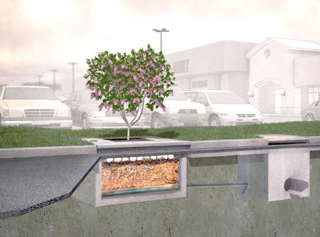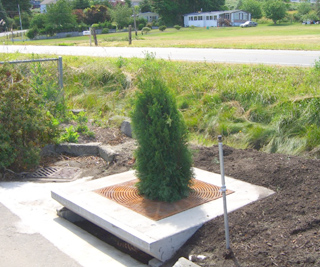
Surveys
DJC.COM
July 30, 2009
Improving water quality in Holmes Harbor
Filterra Bioretention Systems

Ruby
|
Stormwater runoff is one of the leading contributors of pollutants to Puget Sound; impairing the health and quality of water, and its habitats. As it rains, water runs off hard surfaces such as roofs, parking lots and driveways and accumulates pollutants as it travels to the storm drain. Eventually, runoff pollutes nearby streams and waterways with trash, fertilizers, oil and grease, metals, animal waste, and other pathogens.
On Whidbey Island, county officials were aware of the adverse impact polluted stormwater runoff was having on Holmes Harbor’s water quality and shellfish health. As the problem persisted, the state Department of Ecology required Island County to establish a shellfish protection district program designed to promote efforts for cleaning the harbor and improving water quality.
Stormwater solution

Images courtesy of Filterra Bioretention Systems
The Filterra system includes a landscape container with engineered media and a plant to naturally remove pollutants from stormwater. |
In an effort to reduce pollutants in Holmes Harbor and to protect the commercial shellfish beds, Island County Planning and Community Development installed a Filterra Bioretention System at Freeland Park.
The Filterra system combines a landscape plant with an engineered filtration media to naturally capture and remove stormwater runoff pollutants, prior to discharging treated runoff into the local waterways. As it rains, polluted stormwater runoff enters the system and flows through a specifically designed filter media mixture contained in a landscape container. The filter media captures and immobilizes pollutants; biological systems then break down these pollutants and they are incorporated into the biomass of the Filterra system. The stormwater continues to flow through the media into an underdrain system at the bottom of the container where treated water is discharged.
Island County staff chose a Thuja occidentalis arborvitae for the stormwater system to help remove pollutants while adding aesthetic value to the surrounding landscape. The project cost and installation of the system was grant-funded by the state Department of Ecology in partnership with Island County and Whidbey Island Conservation District.
Educating the community

A Filterra stormwater treatment system installed at Freeland Park is reducing pollutants in Holmes Harbor. |
In addition to using the Filterra system to improve the harbor’s water quality, the county has also launched environmental and public awareness programs to educate the citizens about reducing their impact on the environment. Public awareness signage sits next to the Filterra system to explain pollution sources in Holmes Harbor, how the system removes pollutants and improves water quality, and how citizens can help keep the harbor clean by using public transportation and eliminating the use of fertilizers and pesticides in yards and gardens.
The county has also distributed seasonal informational flyers, developed environmentally friendly car-washing kits, and launched a scoop-the-poop campaign that includes pet waste stations along popular walking areas.
Mindy Ruby is the research and development manager for Filterra Bioretention Systems.
Other Stories:
- How people influence long-term sustainable success
- For a greener future, look to the past
- Going green with government tax incentives
- Puget Sound’s invisible enemy: polluted stormwater
- Are you sure you’re ready to go green?
- Is vapor intrusion the next regulatory juggernaut?
- Fish find refuge on the lower Puyallup River
- A watershed approach to mitigation and restoration
- Why buildings can never be regenerative
Copyright ©2009 Seattle Daily Journal and DJC.COM.
Comments? Questions? Contact us.